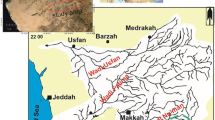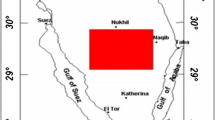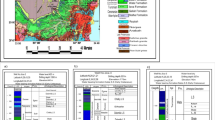Abstract
Two geophysical tools were used to delineate the configuration of the Nubian sandstone aquifer in the study area. Three hundred magnetic points were measured and analyzed to evaluate the subsurface structural setting and to trace the basement relief, which control the aquifer’s geometry. The magnetic interpretations refer to dominant faults that strike in various directions, namely N–S, NE–SW, and NW–SE. The top of the basement complex was recorded at depths of 384–1286 m, and the aquifer thickness ranged from 299 to 1169 m. Thirty vertical electrical sounding points of AB/2 with depths ranging from 1.5 to 700 m were used to estimate the parameters of the Nubian sandstone aquifer. The geoelectrical data indicate that the area consists of 5 units; the first unit is composed of sand and gravel, the second unit of ferruginous sandstone, the third unit of clay, the fourth unit of dry sandstone, and the last unit of sandstone saturated with groundwater. The groundwater in the study area is freshwater of high quality usable for all purposes.

(modified from Conoco, 1987)









Similar content being viewed by others
References
Al Temamy, A. M. M., & Barseem, M. S. M. (2010). Structural impact on the groundwater occurrence in the Nubia sandstone aquifer using geomagnetic and geoelectrical techniques, northwest Bir Tarfawi, east El Oweinat area, Western Desert. EGS Journal, 8(1), 47–63.
Araffa, S. A. S. (2013). Delineation of under groundwater aquifer and subsurface structures on north Cairo Egypt, used integrated interpretation of magnetic, gravity, and geoelectrical data. Geophysical Journal International, 192(1), 94–112.
Araffa, S. A. S., Abdelazium, M., Sabet, H. S., & Al Dabour, A. (2021). Hydrogeophysical investigation at El Moghra area, North Western Desert, Egypt. Environmental Earth Sciences, 80(2), 55–80.
Araffa, S. A. S., Alrefaee, H. A., & Nagy, M. (2020). Potential of groundwater occurrence using geoelectrical and magnetic data: A case study from south Wadi Hagul area, the northern part of the Eastern Desert, Egypt. Journal of African Earth Sciences, 172, 103970.
Araffa, S. A. S., El Shayeb, H. M., Abu-Hashish, M. F., & Hassan, N. M. (2015). Integrated geophysical interpretation for delineating the structural elements and under groundwater aquifers at the central part of Sinai Peninsula. Arabian Journal of Geosciences, 8, 7993–8007.
Archie, G. E. (1942). The electrical resistivity log as an aid in determining some reservoir characteristics. Transactions of the AIME, 146, 54–62.
Attia, O. E. A., & Hussien, K. H. (2015). Sedimentological characteristics of continental sabkha, south Western Desert, Egypt. Arabian Journal of Geosciences , 8, 7973–7991.
Aweto, K. E. (2013). Resistivity methods in hydrogeophysical investigation for groundwater in Aghalokpe, Western Niger Delta. Global Journal of Geological Science., 11, 47–55.
Baranov, V., & Naudy, H. (1964). Numerical calculation of the formula of reduction to the magnetic pole. Geophysics, 29, 67–79.
Bobachev, A, Modin, I., & Shevinin, V. (2008). IPI2Win V2.0: user’s Guide. Moscow State University, Moscow. http://geophys.geol.msu.ru/ipi2win.htm.
CONOCO. (1987). Geological map of Egypt, scale 1:500,000.
El Osta, M. M. (2006). Evaluation and management of groundwater in East El Oweinat Area, Western Desert, Egypt. Ph.D. Thesis. Geology Department, Faculty of Science, Minufiya University.
EL-Badrawy, H. T., Araffa, S. A. S., & Gabr, A. F. (2021). Application of the multi-potential geophysical techniques for under groundwater evaluation in a part of central Sinai Peninsula Egypt. Acta Geodynamics Et Geomaterialia, 18(1), 61–70.
Elbarbary, S., Araffa, S. A. S., El-Shahat, A., AbdelZaher, M., & Khedher, K. M. (2021). Delineation of water potentiality areas at Wadi El-Arish, Sinai, Egypt, using hydrological and geophysical techniques. Journal of African Earth Sciences, 174, 104056.
Goldman, M., & Neubauer, F. M. (1994). Groundwater exploration using integrated geophysical techniques. Survey in Geophysics, 15, 331–361.
Hendriks, F., Luger, P., Bowitz, J., & Kallenbach, H. (1987). Evolution of the depositional environments of the SE-Egypt during the cretaceous and lower tertiary. Subproject A3 “Sedimentary basin of Southern Egypt.” Berl. Geowiss., 75, 49–80.
Issawi, B. (1971). The geology of Darb El-Arbeain, Western Desert, Egypt. Annals of the Geological Survey of Egypt, 1, 53–92.
Issawi, B. (1973). Nubia sandstone type section. Bulletin AAPG, 57, 741–745.
Klitzsch, E. (1978). Geologische Bearbeitung Sudwest-Agyptens. Geologische Rundschau, 67, 509.
Klitzsch, E., & Lejal-Nicol, A. (1984). Flora and Fauna from Strata in Southern Egypt and Northern Sudan. Berliner Geowissenschaftliche Abhandlungen, 50, 47–79.
Masoud, M. H., Schneider, M., & El Osta, M. M. (2013). Recharge flux to the Nubian Sandstone aquifer and its impact on the present development in southwest Egypt. Journal of African Earth Sciences, 85, 115–124.
Oasis Montaj Programs. (2015). Geosoft mapping and processing system: Version 8.3.2 (HJ), Inc Suit 500, Richmond St. West Toronto, ON Canada N5SIV6.
Parker, R. L. (1973). The rapid calculation of potential anomalies. Geophysical Journal International, 31(4), 447–455.
Winsauer, W. O., Shearin, H. M., Jr., Masson, P. H., & Williams, M. (1952). Resistivity of brine saturated sands in relation to pore geometry. American Association of Petroleum Geologists Bulletin, 36(2), 253–277.
Acknowledgments
The authors extend their sincere gratitude and appreciation to the Research Institute for Groundwater (RIGW) for their help in achieving this paper. Likewise, they are grateful to the reviewers who reviewed this research for publication.
Author information
Authors and Affiliations
Corresponding author
Supplementary Information
Below is the link to the electronic supplementary material.
Rights and permissions
About this article
Cite this article
Araffa, S.A.S., Bedair, S. Application of Land Magnetic and Geoelectrical Techniques for Delineating Groundwater Aquifer: Case Study in East Oweinat, Western Desert, Egypt. Nat Resour Res 30, 4219–4233 (2021). https://doi.org/10.1007/s11053-021-09937-y
Received:
Accepted:
Published:
Issue Date:
DOI: https://doi.org/10.1007/s11053-021-09937-y




